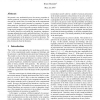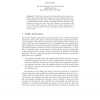143 search results - page 2 / 29 » A Range Test Secure in the Active Adversary Model |
EUROCRYPT
1999
Springer
13 years 9 months ago
1999
Springer
We consider the problem of basing Oblivious Transfer (OT) and Bit Commitment (BC), with information theoretic security, on seemingly weaker primitives. We introduce a general model...
JOC
2000
13 years 5 months ago
2000
The goal of secure multiparty computation is to transform a given protocol involving a trusted party into a protocol without need for the trusted party, by simulating the party am...
TCC
2009
Springer
14 years 6 months ago
2009
Springer
It is well known that general secure function evaluation (SFE) with information-theoretical (IT) security is infeasible in presence of a corrupted majority in the standard model. ...
SP
2006
IEEE
13 years 11 months ago
2006
IEEE
We present a new mechanized prover for secrecy properties of security protocols. In contrast to most previous provers, our tool does not rely on the Dolev-Yao model, but on the co...
CRYPTO
2000
Springer
13 years 9 months ago
2000
Springer
Abstract. While there is a great deal of sophistication in modern cryptology, simple (and simplistic) explanations of cryptography remain useful and perhaps necessary. Many of the ...



